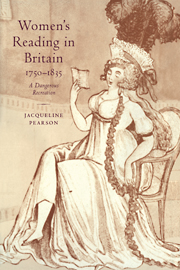Book contents
- Frontmatter
- Contents
- Preface
- Introduction
- 1 Pygmalionesses and the pencil under the petticoat: Richardson, Johnson and Byron
- 2 What should girls and women read?
- 3 The pleasures and perils of reading
- 4 Pleasures and perils of reading: some case histories
- 5 Where and how should women read?
- 6 Preparing for equality: class, gender, reading
- 7 A dangerous recreation: women and novel-reading
- Conclusion
- Notes
- Select bibliography
- Index
4 - Pleasures and perils of reading: some case histories
Published online by Cambridge University Press: 22 October 2009
- Frontmatter
- Contents
- Preface
- Introduction
- 1 Pygmalionesses and the pencil under the petticoat: Richardson, Johnson and Byron
- 2 What should girls and women read?
- 3 The pleasures and perils of reading
- 4 Pleasures and perils of reading: some case histories
- 5 Where and how should women read?
- 6 Preparing for equality: class, gender, reading
- 7 A dangerous recreation: women and novel-reading
- Conclusion
- Notes
- Select bibliography
- Index
Summary
The evidence for the reading-histories of real women in this period is both dauntingly rich and disappointingly meagre. Some left detailed records, but all are white, most from aristocratic, literary or professional families. Nonetheless, despite what seems a limitation, the readers studied in this chapter embody central contemporary themes. Laetitia Pilkington represents a late-Restoration identification of women's reading (and writing) with transgressive sexuality, which she simultaneously protests and uses to her own advantage; reading also serves her as a rhetorical means of claiming middle-class status as she struggled to survive as an impoverished divorced Irishwoman in London. Frances Burney's anxieties about self-assertion, authority, sexuality and a public role are typical of the new conservatism after 1750, and often focus around writing and reading. Elizabeth Carter demonstrates the problems faced by female intellectuals, and both she and Jane Austen demonstrate in different ways how tactics of vigorously resisting reading could be accommodated within apparently traditional modes of femininity. I cover the full chronological range of this study, from Pilkington who died in 1750 to Burney who survived until 1840: their different attitudes will therefore chart changing opinion as well as idiosyncratic differences or those conditioned by different social and family circumstances.
LAETITIA PILKINGTON (1712–50)
Laetitia Pilkington was born in 1712, and her treatment of reading strongly resembles that of women of the previous generation, like Aphra Behn whose transvestite adventuress Sylvia takes a ‘little novel’ to read in bed with her new lover, or Delarivier Manley who persistently identifies women's reading with seduction.
- Type
- Chapter
- Information
- Women's Reading in Britain, 1750–1835A Dangerous Recreation, pp. 122 - 151Publisher: Cambridge University PressPrint publication year: 1999



